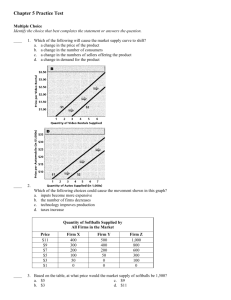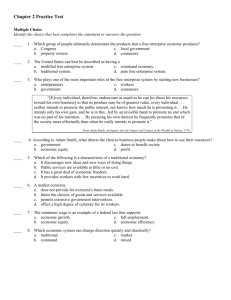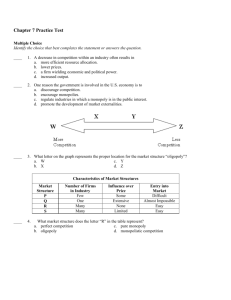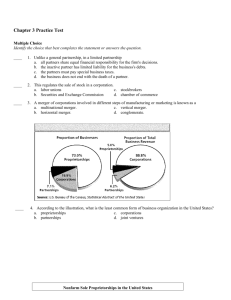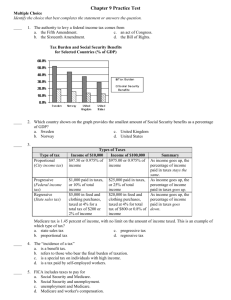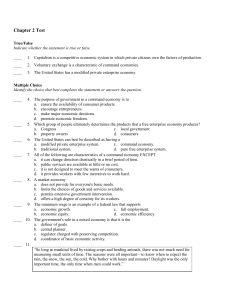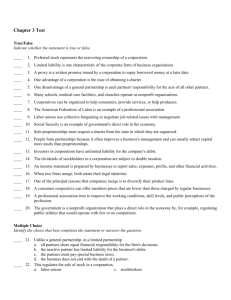Economics Chapter 3 Test: Business Organizations & More
advertisement
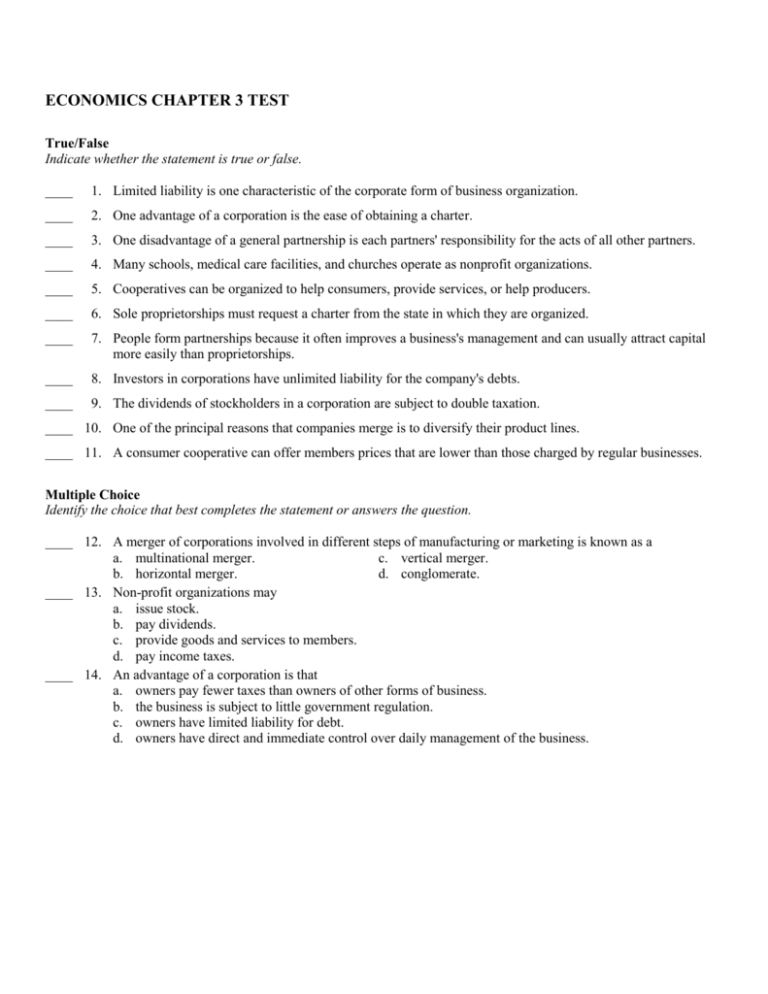
ECONOMICS CHAPTER 3 TEST True/False Indicate whether the statement is true or false. ____ 1. Limited liability is one characteristic of the corporate form of business organization. ____ 2. One advantage of a corporation is the ease of obtaining a charter. ____ 3. One disadvantage of a general partnership is each partners' responsibility for the acts of all other partners. ____ 4. Many schools, medical care facilities, and churches operate as nonprofit organizations. ____ 5. Cooperatives can be organized to help consumers, provide services, or help producers. ____ 6. Sole proprietorships must request a charter from the state in which they are organized. ____ 7. People form partnerships because it often improves a business's management and can usually attract capital more easily than proprietorships. ____ 8. Investors in corporations have unlimited liability for the company's debts. ____ 9. The dividends of stockholders in a corporation are subject to double taxation. ____ 10. One of the principal reasons that companies merge is to diversify their product lines. ____ 11. A consumer cooperative can offer members prices that are lower than those charged by regular businesses. Multiple Choice Identify the choice that best completes the statement or answers the question. ____ 12. A merger of corporations involved in different steps of manufacturing or marketing is known as a a. multinational merger. c. vertical merger. b. horizontal merger. d. conglomerate. ____ 13. Non-profit organizations may a. issue stock. b. pay dividends. c. provide goods and services to members. d. pay income taxes. ____ 14. An advantage of a corporation is that a. owners pay fewer taxes than owners of other forms of business. b. the business is subject to little government regulation. c. owners have limited liability for debt. d. owners have direct and immediate control over daily management of the business. ____ 15. According to the illustration, what is the least common form of business organization in the United States? a. proprietorships c. corporations b. partnerships d. joint ventures ____ 16. What form of business organization does this organizational chart depict? a. partnership c. corporation b. proprietorship d. joint venture ____ 17. What type of merger created Mega Corporation in the illustration? a. horizontal merger c. diagonal merger b. vertical merger d. conglomerate merger ____ 18. What type of merger does the illustration depict? a. horizontal merger c. diagonal merger b. vertical merger d. conglomerate merger ____ 19. What type of merger does the illustration show? a. horizontal merger c. diagonal merger b. vertical merger d. conglomerate merger Largest American-Owned Multinationals Revenue Rank/Company 1. Exxon 2. Ford Motor 3. IBM 4. General Motors 5. Texaco 6. General Electric 7. Citigroup 8. Wal-Mart Stores 9. Chevron 10. Hewlett-Packard Foreign ($mil) 143,044 51,691 51,180 48,233 43,146 42,390 37,396 32,100 31,374 27,230 Total ($mil) 206,083 170,064 88,396 184,632 60,220 129,853 111,826 191,329 69,058 48,782 Assets Foreign as % of Total 69.4 30.4 57.9 26.1 71.554 32.6 33.4 16.8 45.4 55.8 Foreign ($mil) 56,742 19,874 14,348 12,578 7,879 159,367 269,837 25,742 27,126 2,244 Total ($mil) 89,829 45,804 35,797 35,376 15,897 437,006 741,114 78,130 50,832 4,500 Foreign as % of Total 63.2 43.4 40.1 35.6 49.6 36.5 36.4 32.9 53.4 49.9 Source: Forbes, July 23, 2001. ____ 20. Which multinational shown in the table received the largest portion of its income from foreign sources? a. Exxon c. Texaco b. Hewlett-Packard d. Wal-Mart Stores ____ 21. According to the table, more than half of the assets of which company or companies are located outside of the United States? a. Exxon b. Exxon, IBM, Texaco, Hewlett-Packard c. all of them d. Chevron, Exxon Grocery store giant Kroger Co. agreed Monday to purchase rival Fred Meyer Co. in a $12.8 billion deal that will enable Kroger to reclaim its status as the nation’s largest supermarket company.... [Analysts say] the merger is a good deal for both companies, one that should create the economies of scale necessary to remain competitive in the tough supermarket industry. The merger also will enable Kroger to [stay] ahead of rival Albertson’s, which otherwise would have eclipsed Kroger through its $11.7 billion buyout of American Stores Co. in August.... Combined with Meyer, currently the fifth-largest grocery chain, Kroger will operate 2,200 supermarkets in 31 states, boasting $43 billion in annual sales. Source: “Kroger Bags Fred Meyer,” CNNfn, October 19, 1998. ____ 22. What type of merger does the passage describe? a. vertical c. multinational b. conglomerate d. horizontal ____ 23. According to the passage, the merger enabled Kroger to diversify. acquire new product lines. become the industry’s largest company. acquire a new corporate identity. a. b. c. d. Third Quarter Income Statement Sales of Goods and Services: less: Cost of goods sold Wages and salaries Interest payments Depreciation ____ 24. $2,000 650 350 200 200 Earnings Before Tax: less: Taxes (at 40%) $600 240 Net Income: plus: Non-cash charges $360 200 Cash Flow: $560 Which expense category shown at the top of the income statement represents a non-cash charge? a. cost of goods sold c. interest payments b. wages and salaries d. depreciation ____ 25. On the income statement shown in the illustration, what dollar amount represents the total amount of new funds the business generated from operations in the third quarter? a. $560 c. $600 b. $360 d. $2,000 Matching Match each statement with the correct item below. a. form of business organization recognized by law as a separate legal entity having all the rights of an individual b. corporation that has manufacturing or service operations in a number of countries c. voluntary association that buys bulk amounts of goods on behalf of its members d. business owned and run by one person e. price paid for the use of another's money f. investor's responsibility for the debts of a business which is limited by the size of his or her investment in the business g. organization of workers formed to represent its members' interests in various employment matters h. money that is borrowed i. non-cash charge a firm takes for the general wear and tear on its capital goods j. stock of finished goods and parts in reserve ____ ____ ____ ____ ____ ____ ____ ____ ____ ____ 26. 27. 28. 29. 30. 31. 32. 33. 34. 35. sole proprietorship principal depreciation limited liability labor union inventory corporation multinational interest consumer cooperative ECONOMICS CHAPTER 3 TEST Answer Section TRUE/FALSE 1. ANS: T PTS: 1 DIF: Average REF: Learn more about this question in Economics Principles and Practices, page 64, and in the Reading Essentials and Study Guide, Chapter 3, Section 1. For additional practice, complete Chapter 3, Section 1, of the Interactive Tutor Self-Assessment CD-ROM, and visit this book's Online Learning Center at epp.glencoe.com. NOT: Page 64 2. ANS: F PTS: 1 DIF: Average REF: Learn more about this question in Economics Principles and Practices, page 65, and in the Reading Essentials and Study Guide, Chapter 3, Section 1. For additional practice, complete Chapter 3, Section 1, of the Interactive Tutor Self-Assessment CD-ROM, and visit this book's Online Learning Center at epp.glencoe.com. NOT: Page 65 3. ANS: T PTS: 1 DIF: Easy REF: Learn more about this question in Economics Principles and Practices, page 62, and in the Reading Essentials and Study Guide, Chapter 3, Section 1. For additional practice, complete Chapter 3, Section 1, of the Interactive Tutor Self-Assessment CD-ROM, and visit this book's Online Learning Center at epp.glencoe.com. NOT: Page 62 4. ANS: T PTS: 1 DIF: Easy REF: Learn more about this question in Economics Principles and Practices, page 75, and in the Reading Essentials and Study Guide, Chapter 3, Section 3. For additional practice, complete Chapter 3, Section 3, of the Interactive Tutor Self-Assessment CD-ROM, and visit this book's Online Learning Center at epp.glencoe.com. NOT: Page 75 5. ANS: T PTS: 1 DIF: Average REF: Learn more about this question in Economics Principles and Practices, page 76, and in the Reading Essentials and Study Guide, Chapter 3, Section 3. For additional practice, complete Chapter 3, Section 3, of the Interactive Tutor Self-Assessment CD-ROM, and visit this book's Online Learning Center at epp.glencoe.com. NOT: Page 76 6. ANS: F PTS: 1 DIF: Average REF: Learn more about this question in Economics Principles and Practices, pages 57-58, and in the Reading Essentials and Study Guide, Chapter 3, Section 1. For additional practice, complete Chapter 3, Section 1, of the Interactive Tutor Self-Assessment CD-ROM, and visit this book's Online Learning Center at epp.glencoe.com. NOT: Pages 57-58 7. ANS: T PTS: 1 DIF: Average REF: Learn more about this question in Economics Principles and Practices, page 61, and in the Reading Essentials and Study Guide, Chapter 3, Section 1. For additional practice, complete Chapter 3, Section 1, of the Interactive Tutor Self-Assessment CD-ROM, and visit this book's Online Learning Center at epp.glencoe.com. NOT: Page 61 8. ANS: F PTS: 1 DIF: Average REF: Learn more about this question in Economics Principles and Practices, page 64, and in the Reading Essentials and Study Guide, Chapter 3, Section 1. For additional practice, complete Chapter 3, Section 1, of the Interactive Tutor Self-Assessment CD-ROM, and visit this book's Online Learning Center at epp.glencoe.com. NOT: Page 64 9. ANS: T PTS: 1 DIF: Challenging REF: Learn more about this question in Economics Principles and Practices, page 65, and in the Reading Essentials and Study Guide, Chapter 3, Section 1. For additional practice, complete Chapter 3, Section 1, of the Interactive Tutor Self-Assessment CD-ROM, and visit this book's Online Learning Center at epp.glencoe.com. NOT: Page 65 10. ANS: T PTS: 1 DIF: Challenging REF: Learn more about this question in Economics Principles and Practices, page 70, and in the Reading Essentials and Study Guide, Chapter 3, Section 2. For additional practice, complete Chapter 3, Section 2, of the Interactive Tutor Self-Assessment CD-ROM, and visit this book's Online Learning Center at epp.glencoe.com. NOT: Page 70 11. ANS: T PTS: 1 DIF: Easy REF: Learn more about this question in Economics Principles and Practices, page 76, and in the Reading Essentials and Study Guide, Chapter 3, Section 3. For additional practice, complete Chapter 3, Section 3, of the Interactive Tutor Self-Assessment CD-ROM, and visit this book's Online Learning Center at epp.glencoe.com. NOT: Page 76 MULTIPLE CHOICE 12. ANS: C PTS: 1 DIF: Challenging REF: Learn more about this question in Economics Principles and Practices, page 71, and in the Reading Essentials and Study Guide, Chapter 3, Section 2. For additional practice, complete Chapter 3, Section 2, of the Interactive Tutor Self-Assessment CD-ROM, and visit this book's Online Learning Center at epp.glencoe.com. NOT: Page 71 13. ANS: C PTS: 1 DIF: Easy REF: Learn more about this question in Economics Principles and Practices, page 75, and in the Reading Essentials and Study Guide, Chapter 3, Section 3. For additional practice, complete Chapter 3, Section 3, of the Interactive Tutor Self-Assessment CD-ROM, and visit this book's Online Learning Center at epp.glencoe.com. NOT: Page 75 14. ANS: C PTS: 1 DIF: Average REF: Learn more about this question in Economics Principles and Practices, page 64, and in the Reading Essentials and Study Guide, Chapter 3, Section 1. For additional practice, complete Chapter 3, Section 1, of the Interactive Tutor Self-Assessment CD-ROM, and visit this book's Online Learning Center at epp.glencoe.com. NOT: Page 64 15. ANS: B PTS: 1 DIF: Easy REF: Learn more about this question in Economics Principles and Practices, page 60, and in the Reading Essentials and Study Guide, Chapter 3, Section 1. For additional practice, complete Chapter 3, Section 1, of the Interactive Tutor Self-Assessment CD-ROM, and visit this book's Online Learning Center at epp.glencoe.com. MSC: Document Based Question NOT: Page 60 16. ANS: C PTS: 1 DIF: Average REF: Learn more about this question in Economics Principles and Practices, pages 62-64, and in the Reading Essentials and Study Guide, Chapter 3, Section 1. For additional practice, complete Chapter 3, Section 1, of the Interactive Tutor Self-Assessment CD-ROM, and visit this book's Online Learning Center at epp.glencoe.com. MSC: Document Based Question NOT: Pages 62-64 17. ANS: B PTS: 1 DIF: Average REF: Learn more about this question in Economics Principles and Practices, page 71, and in the Reading Essentials and Study Guide, Chapter 3, Section 2. For additional practice, complete Chapter 3, Section 2, of the Interactive Tutor Self-Assessment CD-ROM, and visit this book's Online Learning Center at epp.glencoe.com. MSC: Document Based Question NOT: Page 71 18. ANS: D PTS: 1 DIF: Average REF: Learn more about this question in Economics Principles and Practices, pages 71-72, and in the Reading Essentials and Study Guide, Chapter 3, Section 2. For additional practice, complete Chapter 3, Section 2, of the Interactive Tutor Self-Assessment CD-ROM, and visit this book's Online Learning Center at epp.glencoe.com. MSC: Document Based Question NOT: Pages 71-72 19. ANS: A PTS: 1 DIF: Average REF: Learn more about this question in Economics Principles and Practices, page 71, and in the Reading Essentials and Study Guide, Chapter 3, Section 2. For additional practice, complete Chapter 3, Section 2, of the Interactive Tutor Self-Assessment CD-ROM, and visit this book's Online Learning Center at epp.glencoe.com. MSC: Document Based Question NOT: Page 71 20. ANS: C PTS: 1 DIF: Easy REF: Learn more about this question in Economics Principles and Practices, pages 72-73, and in the Reading Essentials and Study Guide, Chapter 3, Section 2. For additional practice, complete Chapter 3, Section 2, of the Interactive Tutor Self-Assessment CD-ROM, and visit this book's Online Learning Center at epp.glencoe.com. MSC: Document Based Question NOT: Pages 72-73 21. ANS: D PTS: 1 DIF: Easy REF: Learn more about this question in Economics Principles and Practices, pages 72-73, and in the Reading Essentials and Study Guide, Chapter 3, Section 2. For additional practice, complete Chapter 3, Section 2, of the Interactive Tutor Self-Assessment CD-ROM, and visit this book's Online Learning Center at epp.glencoe.com. MSC: Document Based Question NOT: Pages 72-73 22. ANS: D PTS: 1 DIF: Average REF: Learn more about this question in Economics Principles and Practices, pages 71-72, and in the Reading Essentials and Study Guide, Chapter 3, Section 2. For additional practice, complete Chapter 3, Section 2, of the Interactive Tutor Self-Assessment CD-ROM, and visit this book's Online Learning Center at epp.glencoe.com. MSC: Document Based Question NOT: Pages 71-72 23. ANS: C PTS: 1 DIF: Easy REF: Learn more about this question in Economics Principles and Practices, pages 71-72, and in the Reading Essentials and Study Guide, Chapter 3, Section 2. For additional practice, complete Chapter 3, Section 2, of the Interactive Tutor Self-Assessment CD-ROM, and visit this book's Online Learning Center at epp.glencoe.com. MSC: Document Based Question NOT: Pages 71-72 24. ANS: D PTS: 1 DIF: Average REF: Learn more about this question in Economics Principles and Practices, page 69, and in the Reading Essentials and Study Guide, Chapter 3, Section 2. For additional practice, complete Chapter 3, Section 2, of the Interactive Tutor Self-Assessment CD-ROM, and visit this book's Online Learning Center at epp.glencoe.com. MSC: Document Based Question NOT: Page 69 25. ANS: A PTS: 1 DIF: Average REF: Learn more about this question in Economics Principles and Practices, page 69, and in the Reading Essentials and Study Guide, Chapter 3, Section 2. For additional practice, complete Chapter 3, Section 2, of the Interactive Tutor Self-Assessment CD-ROM, and visit this book's Online Learning Center at epp.glencoe.com. MSC: Document Based Question NOT: Page 69 MATCHING 26. ANS: D PTS: 1 DIF: Easy REF: Learn more about this question in Economics Principles and Practices, page 57, and in the Reading Essentials and Study Guide, Chapter 3, Section 1. For additional practice, complete Chapter 3, Section 1, of the Interactive Tutor Self-Assessment CD-ROM, and visit this book's Online Learning Center at epp.glencoe.com. NOT: Page 57 27. ANS: H PTS: 1 DIF: Average REF: Learn more about this question in Economics Principles and Practices, page 64, and in the Reading Essentials and Study Guide, Chapter 3, Section 1. For additional practice, complete Chapter 3, Section 1, of the Interactive Tutor Self-Assessment CD-ROM, and visit this book's Online Learning Center at epp.glencoe.com. NOT: Page 64 28. ANS: I PTS: 1 DIF: Average 29. 30. 31. 32. 33. 34. 35. REF: Learn more about this question in Economics Principles and Practices, page 69, and in the Reading Essentials and Study Guide, Chapter 3, Section 2. For additional practice, complete Chapter 3, Section 2, of the Interactive Tutor Self-Assessment CD-ROM, and visit this book's Online Learning Center at epp.glencoe.com. NOT: Page 69 ANS: F PTS: 1 DIF: Average REF: Learn more about this question in Economics Principles and Practices, page 64, and in the Reading Essentials and Study Guide, Chapter 3, Section 1. For additional practice, complete Chapter 3, Section 1, of the Interactive Tutor Self-Assessment CD-ROM, and visit this book's Online Learning Center at epp.glencoe.com. NOT: Page 64 ANS: G PTS: 1 DIF: Easy REF: Learn more about this question in Economics Principles and Practices, pages 76-77, and in the Reading Essentials and Study Guide, Chapter 3, Section 3. For additional practice, complete Chapter 3, Section 3, of the Interactive Tutor Self-Assessment CD-ROM, and visit this book's Online Learning Center at epp.glencoe.com. NOT: Pages 76-77 ANS: J PTS: 1 DIF: Average REF: Learn more about this question in Economics Principles and Practices, page 59, and in the Reading Essentials and Study Guide, Chapter 3, Section 1. For additional practice, complete Chapter 3, Section 1, of the Interactive Tutor Self-Assessment CD-ROM, and visit this book's Online Learning Center at epp.glencoe.com. NOT: Page 59 ANS: A PTS: 1 DIF: Average REF: Learn more about this question in Economics Principles and Practices, page 62, and in the Reading Essentials and Study Guide, Chapter 3, Section 1. For additional practice, complete Chapter 3, Section 1, of the Interactive Tutor Self-Assessment CD-ROM, and visit this book's Online Learning Center at epp.glencoe.com. NOT: Page 62 ANS: B PTS: 1 DIF: Easy REF: Learn more about this question in Economics Principles and Practices, page 72, and in the Reading Essentials and Study Guide, Chapter 3, Section 2. For additional practice, complete Chapter 3, Section 2, of the Interactive Tutor Self-Assessment CD-ROM, and visit this book's Online Learning Center at epp.glencoe.com. NOT: Page 72 ANS: E PTS: 1 DIF: Average REF: Learn more about this question in Economics Principles and Practices, page 64, and in the Reading Essentials and Study Guide, Chapter 3, Section 1. For additional practice, complete Chapter 3, Section 1, of the Interactive Tutor Self-Assessment CD-ROM, and visit this book's Online Learning Center at epp.glencoe.com. NOT: Page 64 ANS: C PTS: 1 DIF: Average REF: Learn more about this question in Economics Principles and Practices, page 76, and in the Reading Essentials and Study Guide, Chapter 3, Section 3. For additional practice, complete Chapter 3, Section 3, of the Interactive Tutor Self-Assessment CD-ROM, and visit this book's Online Learning Center at epp.glencoe.com. NOT: Page 76

